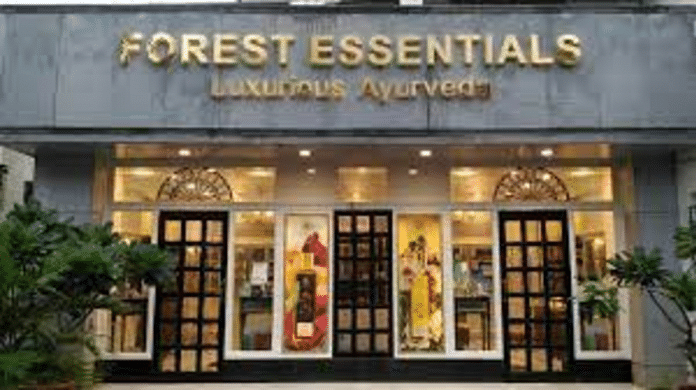It was at this time that Sadeev Sandhu, a very old and dear family friend, came up with a proposition. He owned a lot of property in Khan Market; in fact, the bookstore where we had a counter was a tenant of his. He called me and said, ‘Mira, there is a store coming up on rent in Khan Market, which is rare. If you are interested, I can put you in touch with the owner.’
A full store, in prime Khan Market! It was a wild and exciting possibility.
I asked Sadeev to come over. I called Sanjay, my loyal accountant, to understand the financials. After understanding we had to make a substantial deposit, I asked Sanjay, ‘Do you think we can afford it? Can we justify it?’
His answer was, ‘Ma’am, we must try or we will never know.’
I still trust Sanjay’s judgement implicitly, as I did that day.
I thought briefly of the possibility of it not succeeding—but it was a flash. I had already made up my mind.
Sadeev, Sanjay, Sam and I decided to take the plunge.
Sadeev negotiated with the landlord and we said we had to take a leap of faith. The numbers were alarming, it was our first real store.
The same uncertainty that we had come up against at each new stage appeared. We constantly fell down, unable to see something until it was in our face—we were supposed to know what sales we were expecting, we were supposed to know how to stock, how to train staff, how to keep store staff, how to handle back-end supplies … we had no clue!
I called Vikram, ‘Vicky, we have taken a store in Khan Market, please help. I need a simple elegant design—not ornate.’ He came over.
We set up the store ourselves from start to finish. We could barely afford the rent so time was of the essence, but our enthusiasm was overflowing. Such technicalities! Prakash came in as our new Warehouse Manager. He was brought in by Mahesh. It was the only way we could determine how much stock could fill the shelves.
Then we needed a Manager for the store. I thought of the perfect one for the job—my friend, Savita, who was from an old Delhi family. She was widowed and living alone. Her children were abroad. I asked her if she would manage the store for us. She was very happy to.
It was an unusual store. The staff was different—we sought out good people from good backgrounds, who loved what they did. It was a calculated risk to start with such expenses.
It was an unusual store. The staff was different—we sought out good people from good backgrounds, who loved what they did. It was a calculated risk to start with such expenses.
On the first day, however, our entire stock at Khan Market was sold out.
There was a mad scramble to restock the next day. It was the same the next day and the next. And it continued. In those days, I felt like a newbie learning to rollerblade—frightened and excited at the same time. We had no idea about inventory, no idea about retailing, no idea about anything. Each one of us had to learn on the job. And we were in it together.
Also Read: Top 10 Emerging Women Entrepreneurs of the year 2021-22 by Fame Finders
When I look at it in retrospect—the Khan Market store seems a bit unreal. If we had thought about it, it would not have happened. The reality was we had no retail experience—forget retail, we had no experience on how to sell, how to display or process for billings! The only person who had worked in a chemist store earlier was our Supply Chain recruit, so we all turned to him for advice. Firstly, he only knew stocking the way it was done in pharmacies—so there were rows and rows of products. When I saw the dozens and dozens of products stocked one next to the other and behind, I said, ‘This does not seem right’. ‘No, ma’am,’ said our new recruit. ‘Aise hi hota hai retail mein (This is the way it works in retail).’ It still didn’t seem right. So I climbed on the ladder to the top shelf and started removing products. Yes, that was better. ‘Nahi nahi, ma’am. Ab toh shelf bikul khali lag raha hai. Sab sochenge ki humare pass kuch stock nahin hai (No, no, ma’am, the shelves are looking absolutely empty now. Everyone will think we have no stock)!’ I convinced Prakash that the three or four products on each shelf looked much more premium and they only had to keep replacing it (if it sold!) from the back room. So everyone in the store who believed that I was wrong reluctantly removed stock from the shelves. When people started coming in and loved the minimalistic look, it became everyone’s else’s collective idea, which was fine.
The how to sell was only common sense I became the de facto trainer who had no idea how to sell. However, I applied some basic rules which were, never come on too strong. Explain the product and listen to what the client wants. Listen was the operative word. Most people don’t listen to what exactly the other person wants, or doesn’t. Never recommend anything to anyone which you don’t feel works for them, just to sell it. It will not work in the long run and they will not come back. When you present someone a product, it should be done with care, thoughtfully wrapped and beautifully presented. We were the first to add fresh flowers and neem leaves into our carry bags. Even the neem leaves were cleaned and dried just so, so they still looked fresh but were not brittle. Finally, we sprayed some scented mist over the bag which added the delight factor.
But there was one thing that I knew clearly—how our clients must be treated. For my clients, buying in our store had to be a luxurious experience in itself.
Each visitor got time, attention and an atmosphere inside the store. If he or she bought a product, they got it wrapped in sweet scented crisp tissue, sprinkled over with fresh flower petals and neem leaves, inside an attractive paper bag. I would personally train each boy and each girl that showed up for the sales work in the store—how they were to talk, how they were to wrap the products, how a ribbon was to be tied to the handle of the bag … I would be there every day to witness the processes for myself. The size of the neem leaf, the colours of the flowers—all had to be perfect.
As the days passed, Savita began to call me whenever there was a well-known face visiting our shop. Gradually, it started becoming a daily occurrence:
‘Today Priyanka Gandhi came to make a basket for her mother’s birthday.
‘So-and-so wanted a wedding gift.’
‘A wanted to gift this to someone who is travelling abroad.’
Every day we used to get frantic calls, ‘We have no stock—send quickly.’ It was time to learn inventory management—how to restock, how to forecast sales …
Within three months, we realized that the Khan Market store was a success. A success that had no strategy and no future business plan as yet. We began to get different kinds of opportunities for greater exposure to our brand—a counter in larger stores, in pharmacies, in good grocery shops.
Also Read: From Lakshmi to Lakmé — story of India’s first cosmetic brand, envisioned by PM Nehru
This would immediately make us visible and accessible everywhere, in ready, standing stores. I was overwhelmed by those offers. They promised quick results.
But that voice in my head was speaking as usual. And it had the same clarity that had led me till here: Forest Essentials was more than a product. It was an experience. A luxurious feeling of well-being. Our products were one part of the whole thing. We needed our own store to create that experience.
We needed our ethos to speak when a potential client came to us—right from how he or she felt when they entered, to how they felt with our salespeople, to when they browsed through the shelves, to when they tried a product, to when they used each one of the products. At each step, they had to feel special … Our first store had shown me the importance of our own space whose quality we controlled.
So, the route I decided was for Forest Essentials to have its own stores.
I fully realized that this would take longer, that this was likely to be harder. Yet, I knew that it would be worthwhile, that there was no other way to be Forest Essentials.
Sam agreed with me. To say no to the many offers was difficult but we did it.
The front end—the selling—began to settle down and become a predictable manageable process over time.
We made mistakes, we incurred costs because of them, but we were also learning the right ways. After that the next phase was to concentrate on the back end. The back end was production.
 This excerpt from ‘Essentially Mira’ by Mira Kulkarni has been published with permission from HarperCollins Publishers
This excerpt from ‘Essentially Mira’ by Mira Kulkarni has been published with permission from HarperCollins Publishers



